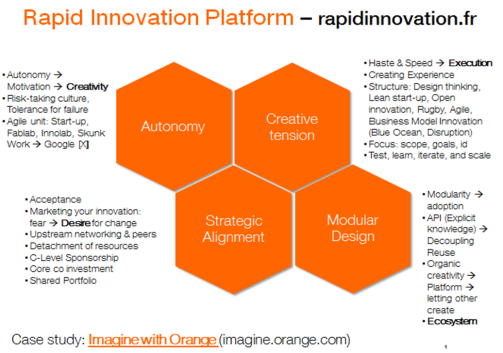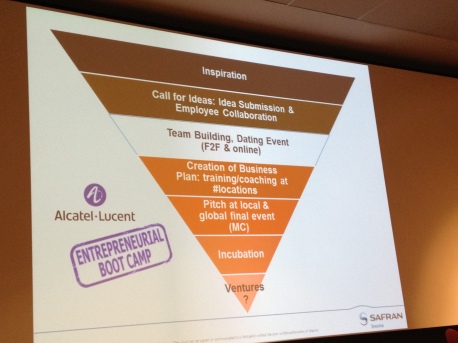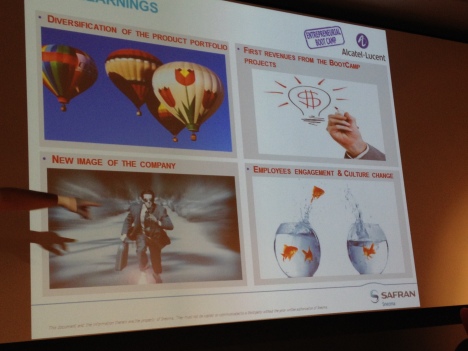Participative Innovation
Participative innovation relies on the objective to make innovation part of every employee’s job. It often translates trough an idea box, initially looking like a mail-box. In the digital world, the idea box has changed into an idea sharing platform, with social features where the community can submit ideas, comment on them, and vote for their favorites.
Thus, the selection process can mix:
- most appreciated ideas based on employees votes; the benefit of the public prize is to maintain a widespread involvement: people realize they can have an impact with their vote;
- a jury selection, involving internal managers of the company, and sometimes external experts. It is an opportunity to involve business units managers in the selection process, so that they can express their ‘buy-in’ upstream, and support ideas’ implementations later on.
Then comes the time for the reward: what’s more exciting than to see one’s idea turn into reality. It sounds natural to put the idea’s owner in capacity to transform his idea into a project: after all, he should the most motivated person to work on his idea! Besides, idea’s owner is in the best position to keep the initial innovation intent undamaged.
To help idea owner to structure its project, a coaching is often necessary: this training for intra-preneurship will traditionally unroll over several weeks, and tackle successively topics like:
- Value proposition, target, usage / persona, features, and customer experience;
- Business model innovation, and ecosystem development;
- Environment, and competition;
- Feasibility, from MVP to product roadmap;
- Innovation marketing, and social media;
- And of course, ‘The Art of Pitching your Project’!

A key question along the process will be to arbitrate whether the innovation will benefit most from integrating an existing business-unit, or should look for autonomy, in a start-up mode. This can give birth to:
- A complete spin-off or a brand new business unit;
- An half-cast unit (or ambidextrous framework: “The Ambidextrous Organization” by Charles A. O’Reilly) which borrows certain assets of the core co, (branding, distribution channels, purchase conditions, partnerships), while preserving its agility, akin the ‘rapid innovation’ platform.
Several companies have set-up successfully participative innovation process, with some specific focuses:
- At Ubisoft, an idea box collects creative concepts from the international network of studios, with a strong emphasis on social features: exposure of idea’s owner, comments, etc… Collective intelligence benefits from differentiated roles: contributors are not the same as activators, the latter sustaining ideas’ flow.
- Renault Creative People fosters ideation: it is dedicated to “internal creativity” mission explains Lomig Unger. We ask people – all over the company – to propose ideas related to a specific theme, going from Frugal innovation to Biomimicry; then ideas are sorted, and the “feasible ones” are linked to the expert inside the company, and concurrently, 2 or 3 workshop are dedicated to original ideas; another channel is the “incubator”: in The Creative People Lab, handled by Mickaël Desmoulins, you will have help, and a place to explore, try, draft, prototype;
- IBM Jam orchestrates insights of employees across all continents; IBM inner crowdfunding platform provides to pilot employees $100 to invest in colleagues proposals, and fosters cooperation across departments and the globe;
- Airbus Protospace is a corporate Fab Lab stressing on rapid prototyping, tells Vincent Loubière, collocating design and prototyping skills, materializing quickly emerging concepts, and ‘Leading by Demonstration‘;
- BNP Paribas emphasizes achievements as well: Aude Albert pitches its network of innovators competing for the Innovation Awards, which values implemented innovations; the winners can be considered as pilots, that can be further rolled-out all over the company;
- Alcatel-Lucent organized 2 years ago an Entrepreneurial Bootcamp contest open to all employees according to the process that Olivier Leclerc explains: online call for ideas, team building & dating event, creation of business plan with training / coaching supported by French Business School, pitch at local and global final event, incubation, and internal or external ventures; it has been followed with a space for innovation, a FabLab called Le Garage.
- Safran Snecma Fab Lab welcomes every employee’s ideas points out Fabrice Poussière: it proposes a complete approach to turn idea into business, from ideation, to prototyping, experimenting, and testing the concept in customer’s hands;
- Participative innovation at Servier entails pairing idea owner with a coach in R&D;
- Seb Lab offers several modules that Jean-Christophe Simon details: Prospection, Creativity, Materialization, and Test: one can pick-up the module he needs, and then dedicated sessions are handled in one place, in one or two days time, with all necessary skills;
- Adobe settled an original Innovation Box: the Kickbox Programme; anyone with an idea can request a Kickbox. This contains instructions on how to approach developing and refining an idea, and it also includes a pre-paid credit card with $1,000 on it; out of 1,000 individuals went through all 6 stages, which amounted to 23 sets of ideas reaching the next ‘blue box’ stage of investment;
- I-Lab is an agile and accurate structure which aims at creating new business revenues at significant level within 15 years, inventing a fifth business unit at Air Liquide, presents Gregory Olocco.
Additional examples of fostering an innovation culture and letting the start-up spirit enter a large company, diversifying product portfolio and creating new revenue streams, can be found in the Innovation Toolbox post, which is already 4 years old: a great deal has happened since then in term of unleashing innovation!
Stay tuned for the next episode: Crossing Participative Innovation with Open Innovation (2/2)




3 Comments